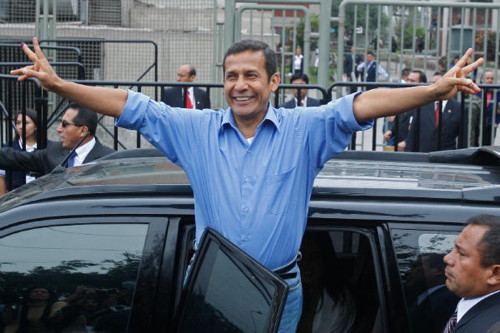
(above) Ollanta Humala, who edged out Keiko Fujimori in Sunday's presidential race, was seen by many as the lesser of two evils. Photo: Karel Navarro.
Five points on the victory of Ollanta Humala in Peru
June 6, 2011 - Christian Science Monitor
Mr. Humala narrowly defeated Keiko Fujimori in Sunday's presidential race. Both candidates were dogged by their pasts, but here are five factors that could influence his future administration.
By James Bosworth, Guest blogger / June 6, 2011
The least bad. As with 2006, many voters looked for the "least bad" candidate, but unlike 2006, they decided Humala was the lesser of the two evils this time. It's a testament to the Fujimori legacy that so few voters were willing to give his daughter a chance. It's also vindication for Mario Vargas Llosa, who is having a pretty good year, as his early endorsement of Humala in the second round was likely a key tipping point in this election.
Outside the capital. Humala's strength comes from outside the capital, where the last two presidents have been weak. The expectations for him outside the capital are big, and he will have a number of early challenges on his plate including ongoing protests in Puno and questions of development rights and taxes. Whatever you think of Humala, it's fair to say that Peru needed a president who is less Lima-centric and now they have it. The question is whether he is able to use his political capital from that base of support to resolve some of the country's tough issues, or if he ends up losing his political base over those issues.
Inside the capital. Of course, the opposite is true, too. Humala's big weakness comes inside the capital, where he won only about 40 percent of the vote and much of that was reluctant support. Lack of support in capital cities is a key indicator of instability. The media attacks and whisper campaigns are not likely to stop now that he is president. There is plenty of Lima intrigue for Humala to navigate.
Common policy ground. The surprising part is, despite the polarized campaign rhetoric (and analysts' insistence that they were ideological opposites), Humala and Fujimori offered a number of very similar policy proposals. They were both promoting very tough security plans, almost mano dura-like in their focus. They both proposed windfall taxes on extraction companies. This election was personal, but in the policy arena, the Peruvian population wants some changes and wants effective government. There are areas for cooperation in the Congress and even a mandate for certain policies among the population that could give Humala some early legislative victories if the various sides can put aside their animosity.
Political reconciliation or polarization. While policy substance is more important, the first indicator of Humala's path will be his style. Does he try to fix the polarization that occurred during this election and reach out to his opponents, or does he thrive off of and demonize his opposition as a way to rally his base? Obviously that doesn't all fall on Humala's shoulders as his opposition, including Fujimori supporters, must also make the choice of what style of opposition they will exert. I'm hoping Humala keeps those Brazilian advisers around a bit longer to guide him along the path of governance. Humala's Lula-like transformation should not end with the campaign win, but should continue into his ability to build political coalitions with centrists and avoid the "us vs. them" style of politics that would worsen the divide that already exists in Peru.
-- James Bosworth is a freelance writer and consultant based in Managua, Nicaragua, who runs Bloggings by Boz.